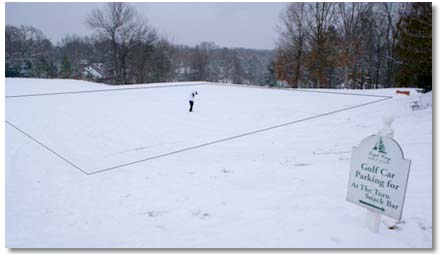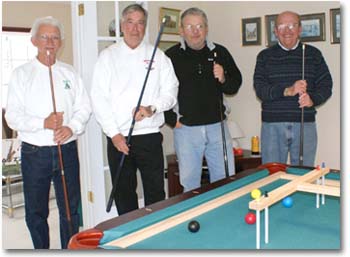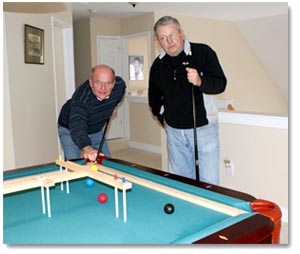

|
Back to |
| The Front Page |
| News & Features |

|
Give your pool table a second life with Crokool |
|
by George Noeth, with Howard Miller and Bob Alman Photos by George Noeth Posted January 17, 2011
|
George Noeth and Howard Miller are friends who live in Tega Cay, South Carolina, and play USCA croquet at the big new club there. George was so impressed with what he and Howard did to Howard's pool table that he sent words and pictures to Croquet World. We're delighted to share their story here.
You can't play croquet if your court is blanketed with two feet of snow or if the surface is frozen too hard to drive in a hoop. And you won't head for a warmer climate if your mate exhausted all your discretionary cash and credit over the holidays. Of course, you could play pool until that game bores you.....and that's when you might come up with Crokool.

|
| This South Carolina croquet court covered in snow inspired the development of indoor Golf Croquet on Howard Miller's pool table. The approximate boundary is marked for scale. |

|
| From left, Ron Jordan and Tom Anderson are the white team, while George Noeth and Howard Miller are the black team. As we publish, the Noeth and Miller team are undefeated Crokool champions. |
The hoops, connected by wooden strips, sit atop the pool table and do not damage the surface if they're sheathed in white plastic tubing. All the components are easily available at the hardware store, and they're easy to assemble.
Now that word has spread of Howard's invention, it's not uncommon to see the members of the ROMEO club (retired old men eating out) playing spirited games of Golf Croquet doubles on his billiards table after dinner. The competition is intense.
Putting it all together

|
The hoops and center stake are quarter inch carriage bolts six inches long inserted through holes drilled in the wood strips. They're held in place by nuts and washers. We slipped white plastic tubing over the bolts and rubber tips on the bottom to prevent damage to the pool table surface.

|
We built the unit in my workshop. Nothing was used that would not be readily available in a hardware store or a big-box home improvement outlet.
The editor asked if we'd be willing to put together the complete assemblage and mail it to people who want to have this conversion but don't want to do the work of getting the materials and putting them together. After consideration, we decided we would do this for $239 including the shipping in North America. But we recommend doing it yourself. If you live in another country, send an email inquiry about cost and payment to georgenoeth#comporium.net, and include the exact dimensions of the pool table inside the rails. If you decide to try it yourself we will gladly answer any questions that come up during construction.
Golf Croquet rules adapted for Crokool
The standard rules need little adaptation for Golf Croquet played on a pool table with this equipment. Blue and black are partner balls against red and yellow, and the balls play in sequence, beginning from the corner opposite next to Hoop #4 (the parallel corner). After that initial tee-off from the corner, all the balls play from where they rest. There is only one stroke per turn; no extra shots are gained by hitting other balls or scoring hoops.
Hoops are played in the direction of the course around the four corners and up the middle, after which the direction is reversed and the course is played counter-clockwise. The winner is the first side to achieve seven points, with the third hoop as the 13th point if it's needed to break a six-six tie. (The center peg has no purpose beyond reminding players of the order of play: blue/red/black/yellow.)
For people who already play WCF Golf Croquet, the main rule changes for Crokool are: (1) The jump shot is strictly prohibited. (2) If a ball is struck too hard it is likely to climb over the side strip and go off the table. When this happens the player is penalized by loss of turn and the penalized ball is placed in the corner farthest from the current wicket.
Rules not yet written in stone
A game only a few months old should not yet have elevated its rules to the status of holy writ. The originators of Crokool encourage you to question the rules and innovate. The rules below are, basically, the rules for Golf Croquet as developed and sanctioned by the World Croquet Federation. But a "hit-in" in Crokool on a standard-size pool table is ever so much easier than one on a croquet court 104 feet long.
Miller comments, "Ball control and cannon shots are much easier in this game with cues and short distances. Another thing that makes seemingly impossible shots possible is a boundary of solid wood; it's easy to hit an opponent's ball and make it travel a long way along the boundary rail."

|
| The two friends and Crokool conspirators play in Howard's rec room. |
The creators of Krokool play USCA croquet at the new Tega Cay Club in South Carolina. They want to know how you like their game, whether you need help in making the equipment, and especially if you have alternate or additional rules to suggest. Email George at georgenoeth#comporium.net.